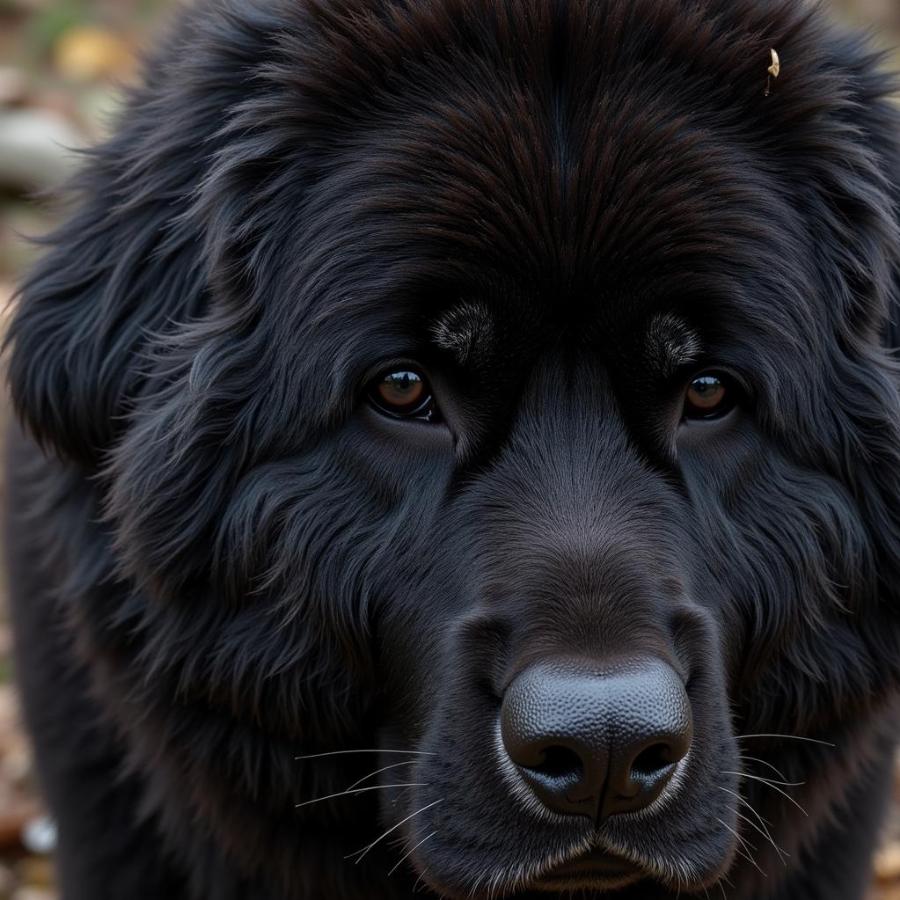Newfoundland dogs, known for their thick, double coats, have a distinct appearance when wet. They transform from fluffy giants to sleek, almost seal-like creatures. Imagine a large, furry bear stepping out of a lake – that’s the closest comparison to a wet Newfoundland. This article will delve into the specifics of a Newfoundland’s wet look, explaining why they look so different and how to care for their magnificent coat, wet or dry.
The Dramatic Transformation of a Wet Newfoundland
So, what does a Newfoundland dog look like when wet? Their thick fur, designed to repel water and insulate them in cold temperatures, becomes saturated, clinging close to their body. This reveals their true form, showcasing a surprisingly muscular and well-defined physique. The fur, usually voluminous and fluffy, becomes smooth and darker, highlighting their deep-set eyes and expressive features. The change can be quite dramatic, making them appear smaller and sleeker than their dry, fluffy selves.
Understanding the Newfoundland’s Double Coat
The dramatic transformation is due to the Newfoundland’s unique double coat. The outer layer is made of long, water-resistant guard hairs, while the undercoat is dense and woolly, providing excellent insulation. When dry, the outer coat traps air, creating the fluffy appearance we associate with Newfoundlands. However, when wet, the guard hairs lose their air pockets and lie flat against the undercoat, revealing the dog’s true form.
 Hình ảnh cận cảnh bộ lông ướt của chó Newfoundland
Hình ảnh cận cảnh bộ lông ướt của chó Newfoundland
Why Does a Wet Newfoundland Look Smaller?
The flattened fur contributes to the illusion of a smaller size. The air trapped in the dry coat adds significant volume, making them appear much larger. When wet, this illusion disappears, and their true, albeit still impressive, size is revealed.
Caring for a Wet Newfoundland
While their wet look can be fascinating, proper care is essential after a swim or bath. Leaving a Newfoundland wet for extended periods can lead to skin issues and matting. Here’s how to care for your wet Newfoundland:
- Thorough Drying: Towel drying is the first step, followed by a thorough blow-dry. Use a low heat setting and brush the fur in the direction of growth to prevent matting.
- Brushing: Regular brushing, especially when wet, helps to remove any tangles and debris. family life new dogs This helps maintain the coat’s health and prevents matting.
- Checking for Skin Issues: While drying, check for any signs of skin irritation or redness. The wet fur can trap moisture, creating a breeding ground for bacteria.
Do Newfoundlands Enjoy Being Wet?
Many Newfoundlands have an affinity for water, thanks to their webbed feet and water-resistant coat. They were originally bred to work alongside fishermen, retrieving nets and rescuing people from the water. Their love for water makes bath time relatively easy, and many enjoy a good swim.
How to Dry a Newfoundland Quickly?
Drying a Newfoundland quickly can be a challenge. Using a high-velocity dryer designed for pets can significantly reduce drying time. 50 lb dog food These dryers force air through the thick coat, pushing out water and accelerating the drying process.
Conclusion
A wet Newfoundland offers a unique glimpse into the true form of this gentle giant. The transformation from fluffy to sleek highlights the remarkable adaptability of their double coat. Understanding the nuances of their wet look and providing proper care ensures their coat stays healthy and beautiful, wet or dry. Remember, proper drying and regular brushing are crucial for maintaining a healthy and happy Newfoundland.
FAQ
- Why does my Newfoundland’s fur change color when wet? The water saturates the fur, causing the light to refract differently, making the coat appear darker.
- How long does it take for a Newfoundland to dry naturally? It can take several hours for a Newfoundland to dry completely naturally, especially in humid climates.
- Is it bad for a Newfoundland to be wet? Not inherently, but prolonged wetness can lead to skin problems.
- Can I leave my Newfoundland to air dry after swimming? While possible, it’s best to towel and blow-dry them thoroughly to prevent matting and skin issues.
- What type of brush is best for a Newfoundland? A slicker brush and a wide-toothed comb are recommended for managing their thick double coat.
- Do all Newfoundlands like water? While many do, not all Newfoundlands are fond of water. kiss dog breed Respect your dog’s preferences.
- How often should I bathe my Newfoundland? Bathing every 2-3 months is usually sufficient, unless they get particularly dirty.
Beaut Dogs is your ultimate resource for all things dog-related, offering expert advice and valuable insights into the world of canines. For personalized guidance on Newfoundland care or any other dog-related questions, contact us at Email: [email protected]. Beaut Dogs is here to help you provide the best care for your beloved companion.